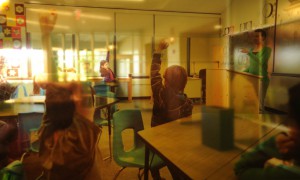Sir Ken Robinson famously describes our education system as “modelled on the interests of industrialization, and on the image of it.“ Whether or not we agree, continuous efforts to revolutionize the education process suggest the statement holds some value. With standardized testing and increasing class sizes steadily quenching the personalized nature of education, educators continue to fall under the strain of attempting to reach every single student on a personal level.
One Size Fits All?
Standardized testing began in the United States in the early 1900s, most notably during the first world war to determine which soldiers were “officer material”, soon to evolve into determining which students were “college worthy”. Advocates for differentiation and personalized learning have denounced the standardized approach to education, embracing research-based findings that students engage with different content in different ways, with one-to-one proving to be the most effective form of instruction.
“It is true that education processes have been modelled on the ‘production line’ and that a ‘one size fits all’ approach has been pursued for the sake of economical and resource constraint reasons”, says Jim Butler, founder of adaptive learning platform, Fishtree. With personalized learning environments setting up the ideal in formal instruction, innovative new trends are rising fast across the education sector. Online and blended learning models are being adopted at increasing speed with 25 states operating state virtual schools, and 29 states and Washington DC operating statewide, full-time online schools. Such movements are coming in response to the rising demand for personalized learning environments that dispel the culture of standardization.
A Call for Change
Every year, over 1.2 million students drop out of high school in the United States alone. That’s one student every 26 seconds, or 7,000 a day. A further 25% of high school freshmen fail to graduate from high school on time. With such figures continuing to focus efforts on the need for change, technology is taking center stage in the search for a personalized solution for every student.
Adaptive technology is attempting to form a solution that overrides the ‘one size fits all’ approach, zoning in on the individual learning criteria of every student. “Technology is not just about the distribution of the message (LMS, ebook etc.) but about allowing the message to be formed and contextualized so everyone can receive it in accordance to their own individual learning preferences”, says Jim.
Referencing Benjamin Bloom’s noted research on ‘The 2 Sigma Problem’, Jim explains how Fishtree found its roots: “The improvements that come from students participating in a highly individualized program of study are far superior to other methods of group instruction, including many of the more favored methods of instruction in use today.” Fishtree forms a solution to the challenge of scaling one-to-one instruction, with the ultimate goal of “allowing software to finally move the cognitive dial by assessing the needs of individuals from an instructional perspective and allowing technology to assist teachers with that, whilst also allowing them to manage the classroom/teaching processes – in one simple wrapper”, he says.
Classrooms of the Future
With the help of self-paced, adaptive systems like Fishtree, educators are being offered the tools to ensure the ‘one size fits all’ approach is abandoned, and a new form of learning takes its place. As hybrid teaching models reach for recognition as mainstream methods, ideas are beginning to spin around the student-centered classrooms of the future, with adaptive technology at the forefront. Jim shares his interpretation of education of the future, “with both teachers and students firmly in the center and technology playing a very important, yet almost subliminal, part in the distribution, differentiation, pedagogical process, management and scaling.”
Technology is re-establishing that essential link between student and teacher, maintaining the personalized aspect of education in an effort to reach out to every single student, and create possibilities for every individual. It’s time we moved away from the age-old, ‘industrialized’ approach to education, and towards a world in which all students receive the personalized experience they deserve. Fishtree is breaking down traditional barriers in an effort to bring personalization to the masses, by creating the most individualized, self-paced learning experience imaginable, that caters to a learner’s needs, rather than overlooking them.
P.S. If you liked this post, you might want to check out fishtree.com. Start teaching with the 21st century learning platform today… the ultimate tool for flipped, blended and mobile learning!
About the author:
Lorna Keane is a teacher of French, English and ESL. She specializes in language teaching and has taught in second and third-level institutions in several countries. She holds a B.A in languages and cultural studies and an M.A in French literature, theory and visual culture. Follow her on Twitter or connect on LinkedIn.
Image credits: Thomas Galvez / CC BY 2.0
